Genre: Platform Developer: Interplay Publisher: Interplay Players: 1 Released: 1994
Superhero extraordinaire Boogerman was originally slated for an illustrious career. This janitor by day/caped crusader by night was featured in countless adds in mid-to-late 1994. In fact, there were plans for a cartoon series, and a sequel for the next generation systems was reportedly in the works. Interplay’s Boogerman: A Pick and Flick Adventure was released for the Sega Genesis in November 1994 to only decent reviews, and all future plans for the character were scrapped (a Super NES version was released in the spring of 1995).
The game admittedly faced stiff competition: other late-1994, 16-bit action games included Donkey Kong Country, Earthworm Jim, The Lion King, Sonic & Knuckles and Mickey Mania. Their popularity far exceeded that of Boogerman, but the latter has become somewhat of a cult classic over the years. It is easy to understand why: for one thing, the title character is instantly recognizable and more than a little obnoxious. Most of the cart’s 24 megs went into Boogerman’s incredibly smooth animation (made up of 1,800 hand-drawn animated cels), whose quality nears that of Earthworm Jim and The Lion King – he moves with grace and elegance, even if his derelict costume is littered with patches and holes. His means of attacks are original, to say the least: instead of throwing fireballs, he throws snot and uses long-range versions of a belch or a fart; meanwhile, short-range burps and farts replace punches and kicks. As in most platform games, it is possible to jump on enemies to defeat them, too. And instead of collecting stars or coins, he collects plungers, as any good janitor would.
In addition to its off-the-wall humor, what makes the game shine is its superb structure. Unlike a top action game like Earthworm Jim, Boogerman does not vary the terrain all that much: every single level has its roots in the Super Mario Bros. -inspired platform genre. This is not a drawback, because the stages are a pure joy to get through. They each have multiple paths for the player to take, and vertical expansion is just as important as the horizontal plane. Many apparent dead-ends actually hide secret passageways, and the most sought-after items (such as extra lives) are often located in remote, hard-to-reach places. Interplay’s programmers humorously twist the Super Mario Bros. heritage: instead of navigating pipes to access underground areas, Boogerman gets flushed down a toilet, which sends him right to the sewers. Just like the pipes in Super Mario Bros., these are side-shows and are not obligatory in order to finish the game. Still, they are too fun to be ignored and offer many power-ups.
Boogerman’s gross-out techniques are perfectly integrated into the gameplay. In other words, their usefulness extends beyond mere spectacle or easy jokes. The responsive controls use three buttons: one for throwing projectiles, one for jumping and one for burping/farting. The projectiles are mostly snot-based, so supplies can actually run out if you don’t get the pertinent power-ups. The burps and farts are of two kinds: simply pressing on C will make Boogerman execute a short-range burp (or fart if he crouches and turns his back to the enemy). On the other hand, charging the C button for a few seconds will make him do a super burp/fart, which turns into a projectile and is in itself a powerful weapon. There is a burp/fart meter that is extended when you collect power-ups such as milk or pepper. Each of these techniques is effective against specific enemies: the player will gradually discover the best strategy as (s)he plays the game. The only control-related quirk has to do with the uneven collision detection, which rarely works in Boogerman’s favor. Jumping on enemies is thus not the best offensive option.
The game has twenty levels divided into five worlds (with five bosses); a password is provided after each stage. The boss battles are isolated from the actual levels and are elaborate one-on-one match-ups with strategically placed platforms – hopping on them sometimes gives you a better angle to attack your enemy but hiding under them can also be a good defensive tactic at some points. These bosses have their own voice and taunts intended for Boogerman and are not too hard to beat: their patterns (usually three to five per boss) can be uncovered after a few tries. The final boss, Boogermeister, is not even the toughest adversary in the game.
The non-Boogerman graphics are extremely effective and capture a seedy, B-film look. Backgrounds are often pitch-black, while foreground elements are dominated by brown, green and red tones. The enemies are tremendously varied: some are minuscule, but others are medium-sized weapon-wielding guard types, birds, hulking giants, or elusive ghosts. The bosses are a sight to behold, usually twice as tall as Boogerman, they each have their own voices and taunts directed at our hero. The whole game has great visual coherence from level to level.
The soundtrack is just as markedly minimalist as the backgrounds. Drum-driven and modestly instrumented tunes provide the main musical themes. There is only one boss theme, but it is memorable. And for once, the Genesis’ infamous audio limitations work in the system’s favor: the basic-sounding soundtrack and garbled voices (both of Boogerman and of his enemies) add immensely to the overall atmosphere. The sound effects are front and center and could not have been more adequate: they are predictably led by a variety of crystal-clear burp and fart noises.
Once you reach the later levels, Boogerman becomes a fairly easy cart – I can beat it with no passwords while using a few lives only. I’m still compelled to play it time and time again, using particular passwords to replay my favorite levels. Boogerman is not the easiest game to find but be sure to pick it up (no pun intended) if you spot a copy. The techniques are so well put together that even platform gamers with little patience for Boogerman ‘s peculiar kind of low-brow humor will enjoy its challenges. This underrated cart is one of the most playable platform games around.
SCORE: 8 out of 10

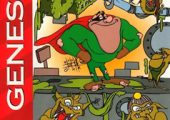
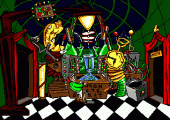
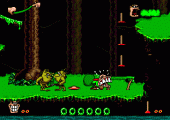
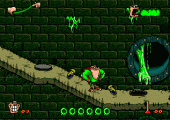
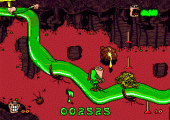
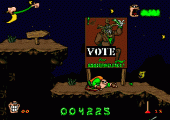
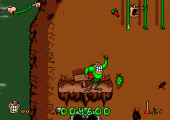
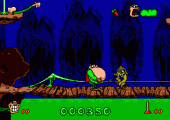
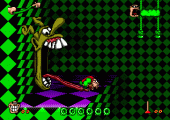
Maybe I don’t “get” the gross-our “humor” of this game, but personally I think it’s a severely overrated title with so-so graphics and unpleasant gameplay
I’m a big fan. It’s a good little platformer. Doesn’t do anything excellent, but the juvenile humor is a plus in my book. Sometimes crass is fun.